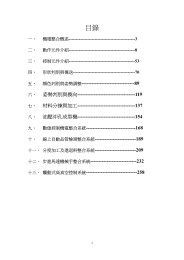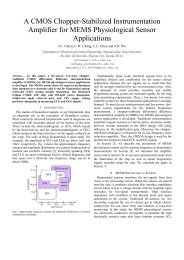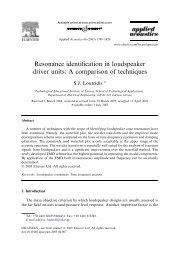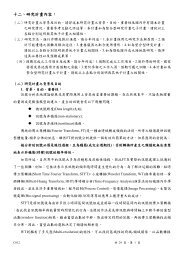IRIS RECOGNITION BASED ON HILBERT–HUANG TRANSFORM 1 ...
IRIS RECOGNITION BASED ON HILBERT–HUANG TRANSFORM 1 ...
IRIS RECOGNITION BASED ON HILBERT–HUANG TRANSFORM 1 ...
You also want an ePaper? Increase the reach of your titles
YUMPU automatically turns print PDFs into web optimized ePapers that Google loves.
α ( ) α<br />
Iris Recognition Based on Hilbert–Huang Transform 631<br />
Fig. 7. The generation of the signal along angle α of each subregion: choose one point of the first<br />
column and connect all the dotted lines.<br />
present the generation of signal series along angle α of each subregion of an iris.<br />
The generation method can be simply described as follows. As shown in Fig. 7, the<br />
rectangle frame denotes one of the subregion of an iris. Firstly choose one point of<br />
the first column and connect all the dotted lines. Then we obtain one signal along<br />
angle α of the subregion. Similarly, we can generate all the signal series (totally<br />
16 signals) along angle α in the subregion. In experiments, we totally choose 18<br />
directions: 0 ◦ , 10 ◦ ,...,170 ◦ .<br />
It is found that it has a good classification performance when the main frequency<br />
centers described as Eq. (5) are used as features for iris recognition. The features<br />
can cluster the samples of same class of iris. As an example, we show three samples<br />
of the same iris and their main frequency centers of 18 directions in I1 in Fig. 8. It<br />
can be seen that the features cluster very well. Furthermore, the gaps are usually<br />
existent for the samples from different classes of iris images. This implies that the<br />
selected features have really a good classification ability for the iris images.<br />
It is also found that the energy e of the main frequency center is also a good<br />
feature for classification. It can reflect the image contrast of different classes of iris.<br />
The higher the contrast is, the larger energy the image has. In other words, a signal<br />
will have a larger energy if it waves in a larger amplitude. Thus, a larger energy<br />
in marginal spectrum can be expected if an iris has the higher contrast. It can be<br />
seen from Fig. 9 that in these three iris classes (a), (b) and (c), the class (a) has<br />
the highest contrast while the class (c) has the lowest contrast. It indicates that the<br />
class (a) has generally the largest energy while the class (c) has the smallest energy<br />
of the main frequency center along the same orientation. An encouraging result is<br />
received as shown in Fig. 9(d). It implies that the energies of the main frequency<br />
center should be also used as features to classify the irises.<br />
As is known, that we choose the main frequency center and its energy as features,<br />
now the feature extraction algorithm is presented as follows.<br />
Algorithm 1 (Feature extraction algorithm). Given a normalized iris image<br />
I(i, j), let its three subregions from the top down divided as Fig. 3 be I1, I2<br />
and I3.<br />
D = {di|di =(i − 1)10,i=1, 2,...,18} — the feature orientations.<br />
. . . . . .

















